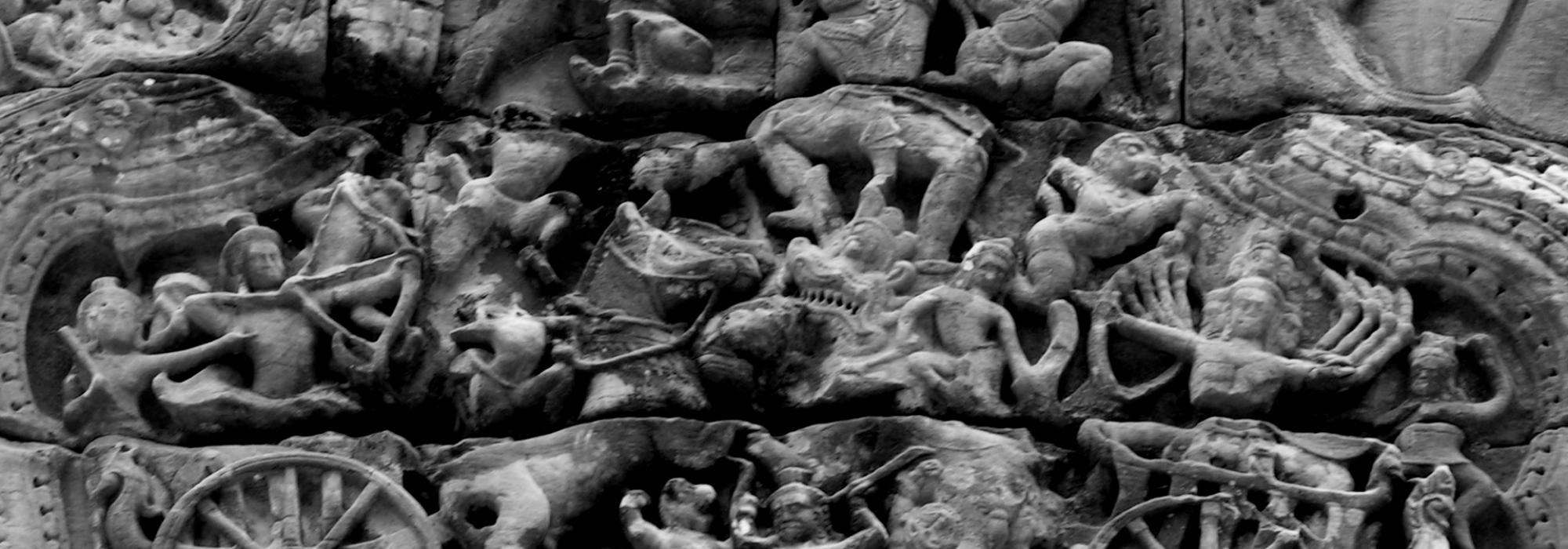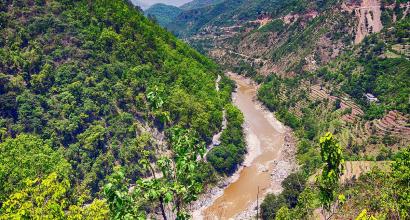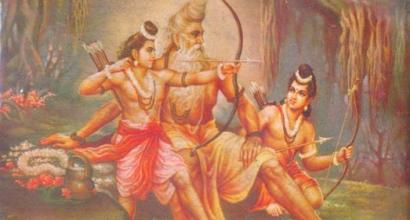Adhyāya 2. Parvasaṅgraha-parva
The second adhyāya contains the Parvasaṅgraha section. This contains information such as the number of parvas in theMahābhārata, the stories contained in them, the number of adhyāyas and verses in each of them. Before this, the seers ask Ugraśrava what the Samanta-pañcaka was, and in response he says, “In the period between the Tretā and the Dvāpara yugas, Paraśurāma killed a number of kṣatriyas. Five ponds filled with their blood were formed. He offered tarpaṇa to his ancestors in those ponds. The region where the ponds were formed is called Samanta-pañcaka. The war between the Pāṇḍavas and the Kauravas was fought in the same region. There the eighteen-akṣauhiṇi army battled each other and met their end.” The seers further asked him what an ‘akṣauhiṇi’ was. In summary, it can be explained thus:
1 chariot + 1 elephant + 3 horses + 5 foot soldiers = 1 patti
3 pattis = 1 senāmukha
3 senāmukhas = 1 gulma
3 gulmas = 1 gaṇa
3 gaṇas = 1 vāhinī
3 vāhinīs = 1 pṛtanā
3 pṛtanās = 1 camū
3 camūs = 1 anīkini
10 anīkinis = 1 akṣauhiṇi
In sum, an akṣauhiṇi contains 21,870 chariots, 21,870 elephants, 65,610 horses and 1,09,350 foot soldiers.
Bhīṣma was the commander-in-chief of the Kaurava army for ten days, Droṇa for five days, Karṇa for two days and Śalya for half a day. In the other half, the mace fight (gadhā-yuddha) between Bhīma and Duryodhana took place. That night Aśvatthāma and the others killed the Upa-pāṇḍavas (the five sons of the five Pāṇḍavas) while they were asleep. Thus the war went on for eighteen days.
Starting from the Anukramaṇikā-parva, the Mahābhārata has a total of one hundred parvas (This includes the two ‘khila’ parvas, i.e., the Harivaṃśa and the Bhaviṣyat, that come after the Svargārohaṇa-parva). These may be called Upaparvas. However, in Naimiṣāraṇya, the following eighteen parvas were named: 1. Ādi, 2. Sabhā, 3. Araṇya, 4. Virāṭa, 5. Udyoga, 6.Bhīṣma, 7. Droṇa, 8. Karṇa, 9. Śalya, 10. Sauptika, 11. Strī, 12. Śānti, 13. Anuśāsana, 14. Aśvamedhikā, 15. Āśramavāsikā, 16.Mausala, 17. Mahāprasthāna, and 18. Svargārohaṇa. Further, the storyline that appears in these eighteen parvas (excluding the Harivaṃśa and the Bhaviṣyat), are discussed along with the numbers of the adhyāyas and the verses. For instance, the Ādi-parva has 218 adhyāyas and 7,984 verses (needless to say, the numbers vary across recensions).
At the end of this adhyāya, the following opinions have risen about the Mahābhārata:
यो विद्याच्चतुरो वेदान्
साङ्गोपनिषदान् द्विजः |
न चाख्यानमिदं विद्यान्
नैव स स्याद्विचक्षणः |२३५|
A dvija, though he might have mastered the Vedas and the Upaniṣads, if he has not gone through this epic [Mahābhārata], he will never attain wisdom.
श्रुत्वा त्विदमुपाख्यानं
श्राव्यमन्यन्न रोचते |
पुंस्कोकिलरुतं श्रुत्वा
रूक्षा ध्वाङ्क्षस्य वागिव |२३६|
Just like one cannot bear the onslaught of harsh sounds of a crow's cawing after having heard the sweet song of the male cuckoo, one can barely find appeal in any work after having listened to this fabulous epic.
इतिहासोत्तमादस्माज्-
जायन्ते कविबुद्धयः |
पञ्चभ्य इव भूतेभ्यो
लोकसंविधयस्त्रयः |२३७|
Just as the three worlds are born of the five elements (pañca-bhūta), later creative minds of poets are rooted in this greatest of epics (also hailed as the pañcama-veda).
अस्याख्यानस्य विषये
पुराणं वर्तते द्विजाः |
अन्तरिक्षस्य विषये
प्रजा इव चतुर्विधाः |२३८|
Just as the four kinds of beings are contained in space, all the Purāṇas are contained in this great epic.
क्रिया गुणानां सर्वेषाम्
इदमाख्यानमाश्रयः |
इन्द्रियाणां समस्तानां
चित्रा इव मनः क्रियाः |२३९|
Just as all the sense organs for their variegated attributes depend upon the mental states, all actions and qualities are enshrined in this epic.
अनाश्रित्यैतदाख्यानं
कथा भुवि न विद्यते |
आहारमनपाश्रित्य
शरीरस्येव धारणम् |२४०|
There's no story in the world that does not draw its inspiration from this epic, just as there is no body that survives without food.
इदं सर्वैः कविवरैर्-
आख्यानमुपजीव्यते |
उदयप्रेप्सुभिर्भृत्यैर्-
अभिजात इवेश्वरः |२४१|
All poets have to resort to this epic for inspiration just as those aspiring to be leaders must serve their overlord.
A Note on the Number of Parvas
In the northern recension and in Kṣemendra’s Bhārata-mañjarī, the gadhā-yuddha that takes place at the end of Śalya-parvahas been made into a separate parva called the gadhā-parva. The Anuśāsana-parva, under the head ‘Mokṣa-dharma’ has been integrated into the Śānti-parva, thus retaining the total number of parvas as eighteen. When a parva could be dedicated to Śalya who led the Kaurava army for half a day, then why not to Duryodhana who managed the army and fought during the other half of the same day? To be fair, it should have been called Duryodhana-parva. The section about the sleeping warriors, Sauptika-parva could well be called Aśvatthāma-parva. The parvas are not named after Duryodhana or Aśvatthāma perhaps because they were thought to be undeserving of this merit.
In some Southern recensions, the Ādi-parva is divided into three as: Ādi-, Āstika-, and Sambhava-parvas; the Śalya-parva into two as Śalya and Gadhā; the Sauptika-parva into three as Sauptika, Aiṣika, and Viśoka; the Śānti-parva into two as Rāja-dharma and Mokṣa-dharma; thus organizing the Mahābhārata into twenty-four parvas (Winternitz: Indian Antiquary, Volume 27, p. 68).
Kumaravyāsa’s Karṇāṭa-bhārata-kathāmañjari follows the model of Kṣemendra’s Bhārata-mañjarī and maintains a division between Śalya-parva and Gadhā-parva. (Alberuni in his Indica refers to the Gadhā-parva.) He says, “Śalyanavasānadali kauravamalla dalapati [āguttāne],” which also has a variant reading. The story in the Gadhā-parva does not end with the death of Duryodhana but goes on till the coronation of Yudhiṣṭhira, which occurs in the Śānti-parva. The Anuśāsana-parvadoes not seem to be considered as an independent parva. (Alberuni also doesn’t refer to the Anuśāsana-parva). The six parvas, starting with the Aśvamedhikā-parva, are not referred to at all. Gāndhāri’s curse to Kṛṣṇa that sets the stage for the Mausala-parva is also missing, except in a couple of manuscripts found of late [c. 1950]. It is unlikely that Kumaravyāsa omitted these sections intentionally. One cannot surmise that his work was brought to an abrupt end due to some difficulties because he gives a logical conclusion to the epic – Kṛṣṇa expresses his gratitude and returns to his hometown; Janamejaya honours Vaiṣampāyana; and the ritual of the sarpa-yāga is complete. Some scholars also opine that the original version of the Mahābhārata contained only eleven parvas. (Venkatachalam Iyer, p. 84). It is noteworthy to ponder over what version of the Sanskrit original existed in Kumaravyāsa’s time and what it contained.
Kumaravyāsa has reduced the prologue until the coronation of King Śantanu in the Ādi-parva to a mere twenty verses. What is the reason for this? Was the original itself this concise? Or was it Kumaravyāsa who condensed it? Alberuni also doesn’t mention the Ādi-parva. Perhaps a good chunk of it is from a later period. In his three benedictory verses, Kumaravyāsa refers only to the benediction by the sūta-purāṇika. He doesn’t give an overview of the parvas nor bring up details about their organization. He doesn’t mention that Ambā had set her heart on Śālva. He uses ‘Duṣkanta,’ an ancient form [of Duṣyanta]. He gives a slightly different version to Vyāsa’s meeting with Ambikā and Ambālikā. The reason for Janamejaya to listen to the story of Bhārata was to atone for the sins he had incurred by performing the sarpa-yāga.
Furthermore, there are reasons to believe that the original Sanskrit version that was available to Nannayya Bhaṭṭa [c. 1050 CE] who wrote the first portion of the Telugu Mahābhārata is largely different from what we have today.
The number of adhyāyas and verses vary across recensions. For example, here is the number of verses in the Ādi-parva as per the following recensions:
C V Vaidya: 8,466
Calcutta edition: 8,479
Lele's publication: 8,621
Kumbhakonam edition: 10,849
Alasingacharya's translation: 8,884
The Śānti-parva (approx. 14,525 verses) is the largest and the Mahāprasthāna-parva (approx. 120 verses) is the smallest in all these recensions.
One wonders upon such examination if the Parvasaṅgraha-parva existed in the original at all. Perhaps, as the interpolations crept into the original text, thus bloating the work, the number of verses mentioned in this parva also underwent changes according.
"But this attribution to Vyāsa is naturally only pūjārthe (honoris causa). It is nowhere suggested in the work itself that the first two adhyāyas of our epic were composed by Vyāsa. They could not be, because they are obviously only a report of the conversation which took place between the Sūta (Ugraśravas, son of Lomaharṣaṇa) and the sages assembled at Śaunaka's twelve-year sacrifice in the Naimiṣa Forest... The figures we find in the Parvasamgraha chapter are fairly old; we cannot say now exactly how old. They are certainly prior to 1000 AD..."
- V S Sukthankar. Epic Questions II. The Parvasaṃgraha Figures. ABORI Silver Jubilee Number pp. 549-53.
To be continued.
Thanks to Śatāvadhāni Dr. R Ganesh for his astute feedback.












































